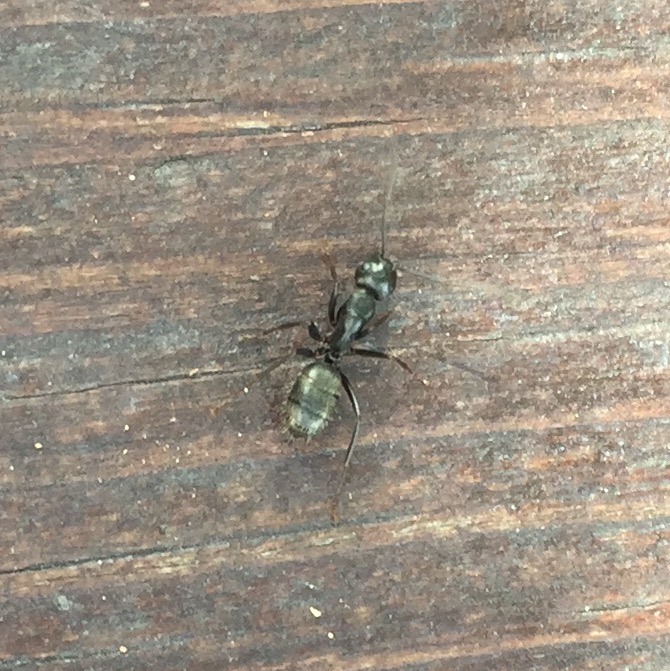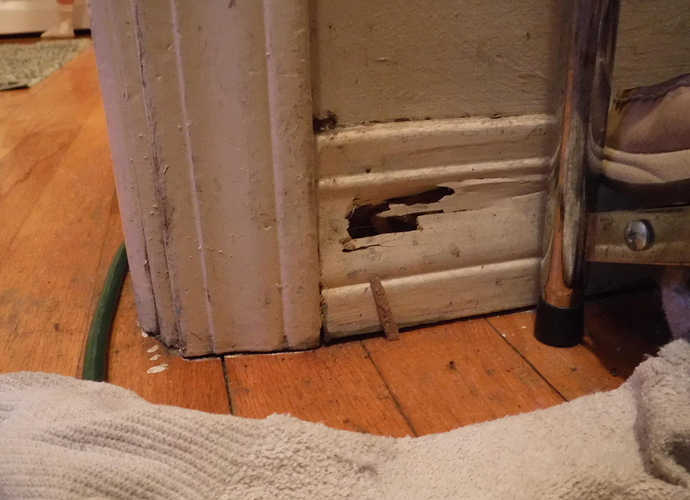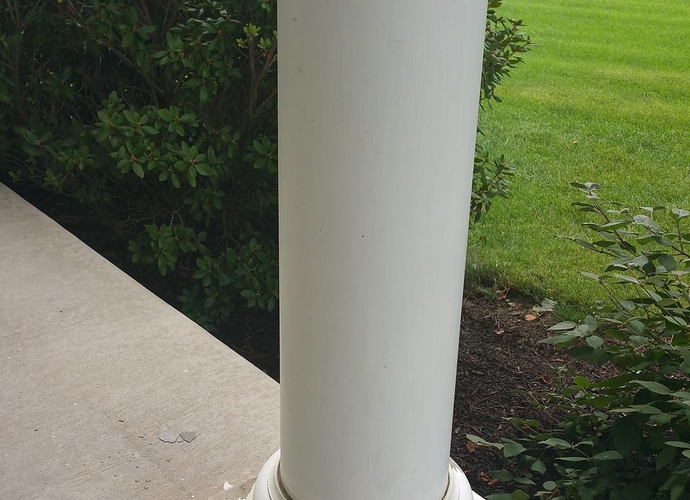This is a picture of the end of my screened in deck. This board is right next to the gutter. The end of the board has opened up because of the elements and needs to be replaced or repaired as to not allow and easier access to termites or other insects.
I read the article on aluminum wiring. I know based on my previous course work that having aluminum branch wiring is a definite red flag because of the risk of a fire. I didn’t know that the reason it was used for a couple years was because at the time it was cheaper then copper wiring. I also did not know that certain insurance companies may not insure the house if their is aluminum wiring in the house.
Ant Inspection
Ants can cause serious damage to a buildings structure an inspector can identify some of these problems by education and knowledge. To identify the difference between an ant and a termite; Ants have elbowed antennae, termites are straight. Ants have a broad waist and termites have a thin waist. Ant’s wings are not the same size and the termites wings are identical (same size).
Ants like to live in damp moist area and normally have hidden nests. Locating a nest can be conducted by tapping along walls and baseboards, listed for sound of ants rustling.
The home owner can take many precautionary steps to prevent infestation by just by keeping food items and residues off surfaces, sealing any external openings into the home sealed.
Would this problem exist if the planter had weep holes in the front of the plant box? or recommend weep holes to the homeowner?
Apparent wood destroying organism damage in laundry room baseboard. Recommend further evaluation by a licensed WDO professional.
Article Review: Bug Zappers
Popular mechanics released a sketch of a bug zapper as early as 1911 but it wasn’t until 1934 that the bug zapper as we know it today came to be. Effectiveness of reducing female mosquito populations is questionable and evidence suggest high numbers of beneficial insects are disintegrated in the process. Apparently bug zappers can redistribute live viruses and bug parts a considerable distance from the device.
Some areas outside this home had a negative slope toward the houses foundation. We entered the crawlspace to see if there were any signs of moisture. None were found but we still checked the moisture level in the posts and joists beneath the house. The readings were satisfactory.
The photo I took shows the distance from the first course on vinyl siding on my house to be about 20" above the soil grade. This is more then the 6" recommended by the standards. Also, note that there aren’t any sbrubs and or trees coming in contact with the house. This is important because carpenter ants can gain access to the house via tree limbs.
This is a picture of aporch column. I was asked to assess thepossibility that it might pose a pathway for wood destroying insectsentrance. The composition of this columnis fiber cement, a material that is not threatened by wood destroying insectsor other organisms.
I read an article regarding growing my inspection business through vehicle signage. It offered many helpful selections such as:
- Clean, neat professionally created signage
- Do not make your vehicle a brochure-- keep it simple and concise
- Keep your vehicle clean inside and out and your signage maintained
- Drive with courtesy as you are the visible face of your business
The article quoted an amazing statistic that my vehicle could offer 5 million views of my business annually.
Certainly, with a little thought, this could be an easy way to grow my business.
Inspecting the exterior of the home which had a fenced in yard and observed the damage caused by carpenter bees on the gates. Both sets appeared to be not in use today. Did not find evidence of additional damage on any of the painted boards on the structure.
Hi,
I live in northwest Florida which has a large rate of subterranean termite damage. Certain times of the year you will see the swarming termites (Alates) flying around the yard. They are so small that they will enter your house and you will see them on the cealings around vents, lights and ceiling fans which can be quite alarming. There are two houses in my area that had thousands of dollars in damage because they thought termite protection was to expensive to buy, now they buy the protection. I have had my house protected since the day it was built. In the pics you can see where they drill holes in concrete and brick to inject the treatment. This treatment is good up to 8 years, but they usually retreat the whole house again every 5 years or sooner if you disturb the soil around the foundation for an addition or building project. The treatment co. then leaves a treatment card to be posted in my case on the electrical panel in the utility room with the date, company name, address and type of treatment. Termite protection is expensive here in florida, but if you plan on moving here I would advise anyone that the protection is a necessary evil.
My wife and I do a lot of composting out of a cement mixer and it is a great way to biodegrade kitchen waste with plant matter that can then be added to soil with fertilizer for healthy gardens around the home. Compost can carry some dangerous pathogens, fungi and bacteria so special care should be taken when tilling composted gardens or planting. Be sure to wear dust mask, eye protection and gloves when mixing compost and and tilling and wash hands when finished. Composting should be done in open or well ventilated containers because composting generates heat that can ignite under certain conditions and should be kept moist. composting should consist of vegetable and plant matter only, meat, bones oils or fats should not be used for they attract unwanted pests like termites, flies, insects and rodents plus they smell bad when they degrade. Compost should not smell bad when properly done.
This picture shows an example of rodding. I never really knew what it was except it was a termite treatment. The use of short rods to treat areas in concrete slabs and brick foundations is discussed in the class. I now know that my house was previously treated for subterrean termites but I did not find any stickers on the hot water heater or electrical panels so I’m not sure when was the last time it was done. I inspected my property pretty closely and did not find any evidence of any type of wood-destroying organisms around the property but am now concerned that there was treatment at some point. I will be calling my friendly wood-destroying organisms treatment company to come out and do a further evaluation.
This is a pic of subterranean termite damage to an external fence. I identified it as a carpenter any gallery but my Inspector friend pointed out that it was a termite gallery. I guess we have to be more intimate with each of the pics and know the subtle differences because to me, after taking the class, it could have been a carpenter bee, carpenter ant or termite damage. I thought that if it was termites, the damage would have been more extensive but hey, I’m a nubie. I’ll be inspecting more homes and hopefully getting more insight in the real world what the differences are and how I can positively identify the culprit.


Hi everyone,
I am completing my research assignment by reading an article in the library and posting what I have learned on the website forum.
Ants as a insect species, particularily Carpenter ants can be destructive to all wood materials that can be found within a typical residential home. They have a social caste system much like termites. Carpenter ants only bore tunnels through the wood to create shelters Versus Termites that actually eat & digest the wood as food in their destructive process.Inspecting EPDM
by Nick Gromicko and Kenton Shepard
I lately observed that EPDM or some plastic material has been used for roofing on a Beaumont AB commercial building .
This article provided comprehensive knowledge I needed ,here is an excerpt
" EPDM (ethylene propylene diene monomer) is a synthetic rubber membrane with elastic properties commonly used to cover low-slope roofs on both residential homes and commercial structures.
INSPECTING EPDM
Seams have been weak points in EPDM installations for many years. Field experience has shown that seams that are watertight when the roof is installed often develop defects within the first three years after installation. "
Great Work Nick & Kenton
Thanks
Waiel Hasan
Edmonton Canada
Hello All
I am including images of my Rotary Hot Air Humidifier as I haven’t observed issues related to WDO in my home
1.Rotary Sponge Type Humidifier requires cleaning prior to heating season
- Humidifier Water Tank should be drained and cleaned due to carbonate and sludge precipitation
Thanks
Waiel Hasan
KPS Inspection
Edmonton Canada
Here is a sub-floor with some dry rot that is in need of some attention. There was not apparent indication of this problem at the vinyl sheet flooring above, i.e. discoloration. Recommend evaluation and repair by qualified tradesmen.
The article Woodpecker Damage Prevention and Inspection jumped out as something I could definitely use during some of my mountain location home inspections. I have seen the damage these creatures have done to some nice homes. Being able to identify the woodpecker behavior with different hole types is pretty cool. Identifying the type of damage and the behavior may held to offer some of the prevention suggestions such as the mesh netting around and under eaves is a good one to help prevent nesting or foraging. I was surprised to see owl effigies are not effective but a hawk models are suggested. I wonder if it is because the hawk models emulate the birds in flight while the owl effigies do not. I have seen the pie tins hanging at some homes in the mountains and wondered if they were effective. In any case being able to discuss with more information to offer homeowners is always a good thing.












